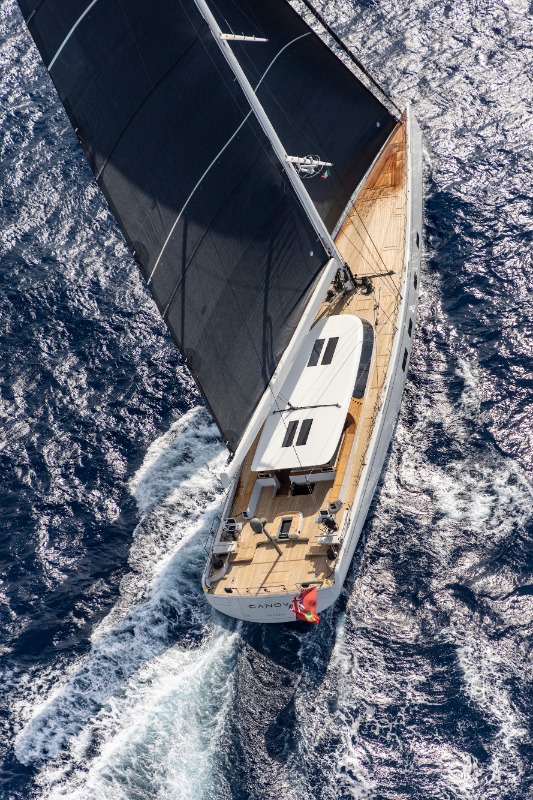Hydrogeneration: crossing oceans without a drop of fossil fuel
Baltic Yachts is enabling its clients to dramatically reduce their environmental footprint and fuel costs…
Sailing a superyacht across the Atlantic without burning fossil fuel may seem inconceivable to some, but Baltic Yachts is using its developments in hydrogeneration technology to make it a real possibility for its clients. The simple concept utilises an electric motor to harness energy created from spinning the propeller while sailing. The electric motor works as an alternator, using the energy created by the free spinning propeller to charge a battery bank which, in turn, supplies power to the sailing systems and services on board. This negates the need for a fossil fuel-run generator, significantly reducing fuel costs and the yacht’s overall environmental footprint.
“Electric motors are increasingly featured on board sailing yachts to drive the propeller or to generate electricity while connected to the main engine, and if the boat is being propelled through the water by the wind in its sails, then we have the opportunity to generate electricity in a reverse capacity while sailing,” explains Henry Hawkins, executive vice president at Baltic Yachts. “With hydrogeneration, it is entirely possible for a sailing yacht to sail across an ocean and generate all of its power needs as it goes.”
The Baltic 142 Canova is Baltic’s first project to feature a hybrid diesel-electric propulsion system designed for hydrogeneration while the yacht is sailing, enabling the use of all services without having to deploy a fossil-fuelled internal combustion engine. The 420kW permanent magnet electric propulsion unit aboard Canova is a fraction of the size of a diesel equivalent and is virtually vibration free and almost silent in operation, meaning increased comfort and significant weight and space savings through reduced insulation.
It can now be said with confidence that Canova could cross an ocean in a moderate breeze, with all her electrical systems working, without using an internal combustion engine to drive a generator...
The average generating capability on Canova’s early trials averaged 27kW when sailing at 16 knots and an output of more than 35kW when sailing at around 20 knots. These and subsequent results have exceeded Baltic’s expectations and it can now be said with confidence that Canova could cross an ocean in a moderate breeze, with all her electrical systems working, without using an internal combustion engine to drive a generator.
The latest developments in battery and electric motor technology has enabled the creation of Baltic’s hydrogeneration system, and these are areas that are still rapidly evolving. As such, for prospective clients that wish to have a future-proofed sailing yacht design, hydrogeneration is a must. “We will see batteries and electric motors getting even smaller, more lightweight and more powerful,” explains Kim Kolam, senior electrical engineer at Baltic Yachts. “In a few years’ time, we might even be able to replace combustion engines with another technology that generates electricity.”
Baltic is also working on developing a hydrogeneration product for refits, incorporating an individual hydrogeneration unit independent of the propulsion system to charge the existing battery bank. “For example, we could use an electric stern thruster that rotates fore and aft to generate power more efficiently than using the main propulsion drive,” adds Hawkins. “This is likely going to be the next step for the technology.”
While misconceptions exist about the complexity involved in hydrogeneration, Baltic’s solution is made up of existing components and an integrated control system that is mostly automated – its operation is likened to the level of control needed for motor-sailing when adjusting pitch to optimise fuel consumption. The major benefits of improved comfort and reduced fuel costs and environmental impact also far outweigh a minimal loss of speed caused by the additional propeller drag. With Canova paving the way to a more sustainable future for sailing yachts, hydrogeneration is expected to become increasingly mainstream.
Image credit: Carlo Borlenghi
Profile links
NEW: Sign up for SuperyachtNewsweek!
Get the latest weekly news, in-depth reports, intelligence, and strategic insights, delivered directly from The Superyacht Group's editors and market analysts.
Stay at the forefront of the superyacht industry with SuperyachtNewsweek
Click here to become part of The Superyacht Group community, and join us in our mission to make this industry accessible to all, and prosperous for the long-term. We are offering access to the superyacht industry’s most comprehensive and longstanding archive of business-critical information, as well as a comprehensive, real-time superyacht fleet database, for just £10 per month, because we are One Industry with One Mission. Sign up here.
NEW: Sign up for
SuperyachtNewsweek!
Get the latest weekly news, in-depth reports, intelligence, and strategic insights, delivered directly from The Superyacht Group's editors and market analysts.
Stay at the forefront of the superyacht industry with SuperyachtNewsweek




